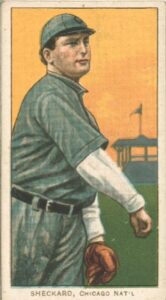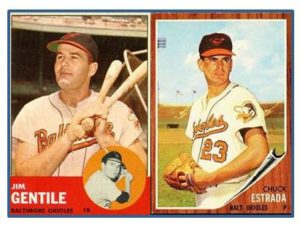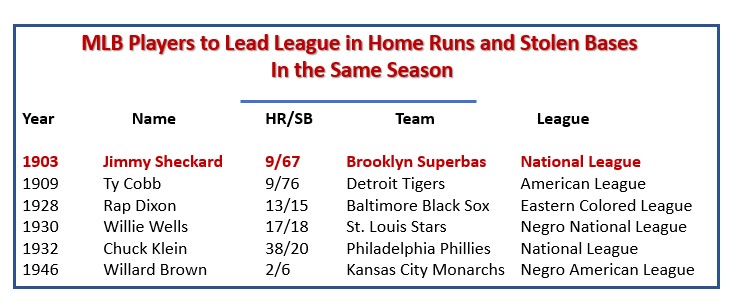In this post, I’d like to share just a few oddball trivia tidbits I’ve come across over time. It’s kind of a stream of consciousness post, going whatever direction the baseball winds (and my whims) take me. (My mind does tend to wander in the off season.) The goal is to present a few tidbits that may offer you a chance to stump your baseball friends when you start to throw around trivia questions over an adult beverage or two (or on a Ballpark Tours bus ride).
Many Questions – One Answer
 Jimmy Sheckard has become one of my trivia heroes. Sheckard enjoyed a 17-season MLB career, during which time he became the answer to:
Jimmy Sheckard has become one of my trivia heroes. Sheckard enjoyed a 17-season MLB career, during which time he became the answer to:
- Who was the first MLB player to poke a walk-off hit in a World Series game?
- Who was the first MLB player to lead the league in stolen bases and home runs in the same season?
- Who was the first – and still only – player to hit inside-the-park Grand Slam home runs in consecutive games?
- Who was one-half of the only pair of teammates to hit inside-the-park Grand Slams in the same game.?
In addition, Sheckard is the answer to:
- Who holds the MLB single-season record for double plays started by an outfielder?
- Who holds the MLB career mark for assists by a left fielder?
Any of these questions would make a pretty good trivial puzzler. Wrap them altogether and you’ve got the makings of a true “trivia hero.” I’ll provide a bit more on Sheckard – his career and his firsts – and then touch on a few additional trivia heroes.
Sheckard played in the majors from 1897 through 1913 (Brooklyn Bridegrooms/Superbas, Baltimore Orioles, Chicago Cubs, St. Louis Cardinals, Cincinnati Reds). He was known as a speedy, strong-armed outfielder. During his career, he led the league in stolen bases twice (a high of 77 in 1899), home runs once, triples once (with eight seasons of ten or more), runs scored once (three season of 100+), walks twice, on-base percentage once and slugging percentage once. He also led in assists, putouts and double plays as a LF four times each. He is, as already noted, the career assist leader among left fielders (243) and number-eight in assists for outfielders overall (307).
Sheckard, at times, showed the talent to be a real star on the diamond. However, inconsistency, worked against him. For example, he hit a career-high .354 in 1901, fell to .265 in 1902, jumped back to .332 in 1903 and dropped to .239 in 1904. Similarly, his nine home runs led the NL in 1903, but he hit a total of nine home runs over the next six campaigns. You get the idea.
So, what about those potential trivia stumpers?
Sheckard’s Chicago Cubs came into Game Four of the 1910 World Series (October 22) trailing the Athletics three games-to-none. To that point, they had been outscored 25-to-9. Playing in Chicago, the Cubs were tied with the Athletics 3-3 going into the bottom of the tenth inning.of Game Four. With future Hall of Famer Charles “Chief” Bender on the hill for Philadelphia, Cubs’ SS Joe Tinker led off the bottom of the inning with a pop out to shortstop, catcher Jimmy Archer followed with a double to left, a groundout by pitcher Mordecai Brown moved Archer to third and Sheckard singled to left bringing in Archer with the winning – and notching the first-ever World Series walk-off hit. (Unfortunately, Sheckard’s heroics only staved off defeat for a day, as the Cubs lost Game Five and the series the next day. They couldn’t blame Sheckard. In 21 plate appearances he was one base 12 times (seven walks, five hits) and scored five of the tam fifteen runs.
How about being the first to lead the league in home runs and stolen bases in the same season? In 1903, playing for Brooklyn, Sheckard led the NL in home runs with nine and steals with 67 (tied with Frank Chance). His .332 average was seventh in the league, his 99 runs seventh, his 29 doubles seventh, 75 RBI eighth; and 75 walks fifth.
Those inside-the-park Grand Slams in consecutive days? They came in a September 23, 1901 in a Brooklyn 25-6 win over Cincinnati and on September 24 in a 16-2 win (again Brooklyn over Cincinnati). In the two games, Sheckard was six-for-twelve, with four runs scored and ten RBI. In 1901, the 22-year-old Sheckard set career highs for average (.354), home runs (11), RBI (104). He also scored 116 runs and had a career-high 196 hits (in 133 games). Notably, in that September 23 25-run outburst, Sheckard’s teammate Joe Kelly also hit an inside-the-park Grand Slam, marking the only time two teammates hit ITP Grand Slams in the same game.
Let’s move on now to a few additional Baseball Roundtable Trivia Heroes.
This Yankee Shortstop Brought ‘Em Home
The New York Yankees have had a lot of great shortstops over time: Derek Jeter; Phil Rizzuto; Tom Tresh; Frank Crosetti to name just a few. So, who is the answer to the question: “Who holds the New York Yankees Franchise record for RBI in a season by a shortstop?”
That would be Lyn Lary, who drove in 107 tallies for the 1931 Yankees – stat line .280-10-107, with 100 runs scored and 13 steals. Lary spent six of his 12 MLB season with the New Yorkers. Notably, 1931 was the only season in his career in which he drove in more than 77 runs (one of only two in which he reached 60 RBI). In fact, his 107 RBI in 1931 represent just over 20 percent of his career total. In 12 MLB seasons (1929-40 … Yankees, Indians, Browns, Senators, Dodgers, Cardinals, Red Sox), Brown went .269-38-526. Side note: In 1931, the Yankees scored 1,067 runs and had six player score 100 or more runs. Want to change up the question? ”
You’ll Have to Earn Your Way On … The Old-Fashioned Way
Here’s another surprise. How about looking at the question: “What qualifying pitcher has the lowest single-season walks per nine innings mark since the four-ball walk rule was instituted?” (Four balls became a walk in 1888, prior to that walks were – at varying times – nine, eight, six and five balls.) The answer? Carlos Silva, who – as a Twin in 2005 – walked just nine batters (and one of those was intentional) in 188 1/3 innings – a stingy 0.430 walks per nine frames rate.
You could follow up this question with: “How many right-handed hitters did Carlos Silva walk in 2005?” The answer is one – the Tigers’ Craig Monroe – and that was Silva’s one intentional walk. So, not a single righty was able to “work him” for a walk all-season. Monroe, by the way, drew only 40 walks in 623 plate appearance n 2005. You might also be interested to know that Silva is the only pitcher – among the 25 best single-season walks per nine rates – whose landmark season came after the four-ball walk rule came into effect.
Silva pitched nine MLB seasons (2002-10 … Phillies, Twins, Mariners, Cubs) and went 70-70, 4.68. He walked 238 batters in 1,241 2/3 innings – 1.5 per nine frames – 2005 was his only season under 1,5 walks per nine.
Rookie Fever
How about this set of questions?
- Who was the first pitcher to throw a shutout in a deciding seventh game of a World Series?
- Who was the first rookie to start a deciding Game Seven of a World Series?
- Who was the fist rookie to win three games in a single World Series?
The answer to all three? Babe Adams.
 Right-hander Charles “Babe” Adams came into the 1909 seasons having had brief MLB “looks” in 1906-07 — no wins, three losses 7.96 in five games (so, his rookie status was intact.). Pitching in the minors in Louisville in 1908, he went 22-12. In 1909, he stuck with the Pirates, getting in 25 games (12 starts/seven complete games) and putting up a 12-3, 1.11 record. Adams was far from the star of the Pirate staff which included Howie Camnitz (25-6, 1.62), Vic Willis (22-11, 2.24) and Lefty Leifield (19-8, 2.37). But manager Fred Clarke like liked Adam’s composure on the mound, his strong finish to the season and how Adam’s stuff and style matched up against the Tigers. So, Adams got the Game One start and the rest is history.
Right-hander Charles “Babe” Adams came into the 1909 seasons having had brief MLB “looks” in 1906-07 — no wins, three losses 7.96 in five games (so, his rookie status was intact.). Pitching in the minors in Louisville in 1908, he went 22-12. In 1909, he stuck with the Pirates, getting in 25 games (12 starts/seven complete games) and putting up a 12-3, 1.11 record. Adams was far from the star of the Pirate staff which included Howie Camnitz (25-6, 1.62), Vic Willis (22-11, 2.24) and Lefty Leifield (19-8, 2.37). But manager Fred Clarke like liked Adam’s composure on the mound, his strong finish to the season and how Adam’s stuff and style matched up against the Tigers. So, Adams got the Game One start and the rest is history.
Adams earned complete-game wins in Games One and Five, giving up just four earned rust Then came the deciding Game Seven. (The World Series’ first-ever deciding seventh game. Adams again went the distance, shutting out the tigers on six hits (one walk and one whiff). Thus, he pitched and won the first deciding Game Seven (as a rookie) and also became the first rookie to win three games in a best-of-seven World Series.
Adams pitched 19 MLB seasons (1906-07, 1909-16, 1918-26 … all but 1906 with the Pirates). He went 194-140, 2.76, twice was a 20-game winner, five times led the league in WHIP, four times allowed the fewest walks per nine innings (among qualifiers) and four time led in strikeouts-to-walks ratio.
BONUS TRIVIA TIDBIT
Red Sox rookie Hugh Bedient has the unique distinction of being the only rookie to start Game Eight of a best-of-seven World Series. (Game Two of the 1912 Series ended in 6-6 tie after 11 innings due to darkness). Bedient, a 22-yer-old right-hander had gone 20-9, 2.92 in his rookie campaign. In the World Series against the Giants, he tossed one scoreless inning of relief in Game Two’s 11-inning tie; one scoreless inning in relief in Game Three’s 2-1 Red Sox loss; and threw a complete-game in Boston’s Game Five 2-1 win. He then started Game Eight (versus Christy Mathewson) and tossed seven scoreless innings in a 3-2 Boston victory. Bedient pitched just four MLB seasons, going 60-53, 3.08.
I Get By With a Little Help from My Friend
In 1961, the Orioles’ Jim Gentile tied an MLB record (since broken) for Grand Slams in a season (five). Who were the starting pitchers in the games in which Gentile launched a Grand Slam? Two-word answer: Chuck Estrada.
 Here’s how it went. In 1961 – with Yankee sluggers Mickey Mantle and Roger Maris dominating headlines in their chase of Babe Ruth’s record 60 home runs in a season – Jim Gentile of the Orioles quietly put up quite a season of his own. Gentile hit .302, with 46 home runs (including those five Grand Slams) and a league-topping 141 RBI. In addition, he tied an MLB record with two Grand Slams in a game – May 9.
Here’s how it went. In 1961 – with Yankee sluggers Mickey Mantle and Roger Maris dominating headlines in their chase of Babe Ruth’s record 60 home runs in a season – Jim Gentile of the Orioles quietly put up quite a season of his own. Gentile hit .302, with 46 home runs (including those five Grand Slams) and a league-topping 141 RBI. In addition, he tied an MLB record with two Grand Slams in a game – May 9.
Orioles’ pitcher Chuck Estrada was the main beneficiary of Gentile’s 1961 offensive outburst – every one of Gentile’s record-tying five four-run blasts was hit in a game started by Estrada (who, as you would expect, picked up a victory in all four contests). Notably, Gentile hit only one other Grand Slam in his career (June 26, 1960) and – you guessed it – the starting and winning pitcher in that contest was Chuck Estrada.
In 1961, Jim Gentile was pretty much an offensive juggernaut when paired with Chuck Estrada. He played in 29 of Estrada’s 31 starts. In those 29 games, he hit .356, with 15 home runs and 47 RBI. How potent is that?
For those of you who like a little more – Don’t baseball fans always want that next fact or stat? – here’s some background. Gentile was in the majors with the Dodgers (1957-58), Orioles (1960-63), A’s (1964-65), Astros (1965-66) and Indians (1966). In nine MLB campaigns, he was an All Star in three seasons (1960-61-62) and 1961 was his best year. His career stat line was .260-179-549. That’s 1961 season saw Gentile reach his all-time career highs in nearly every offensive category. It was the only season in which he reached a .300 batting average, 100 or more RBI and 40 or more home runs (he had a total of five seasons of at least 20 homers – including the 46 in 1961 and 33 in 1962).
Estrada’s best season was his rookie year (1960) with the Orioles, when the 22-year-0ld led the AL with 18 wins (11 losses and a 3.58 ERA). He finished second in the AL Rookie of the Year balloting to his Orioles’ teammate, shortstop Ron Hansen, who hit .255, with 22 home runs and 86 RBI. Estrada was an All Star in just one season – his rookie campaign – in a career that saw him win 50 and lose 44, with a 4.04 ERA. He pitched for the Orioles (1960-64), Cubs (1966) and Mets (1967).
How to (Not) Play Your Way into the Record Book
Charles “Cap” Peterson’s name does not come up in a host of baseball discussions. An outfielder, Peterson played in eight MLB seasons (1962-69 … Giants, Senators, Indians). His career stat line was .230-19-122 and he played in 100 or more games just once. In 1967 (with the Senators), he set career highs in games (122), hits (97), home runs (8) and RBI (46). On June 12 of that season, he tied an MLB record (for inactivity) and became part of the answer to the question: Who holds the record for the longest game played in the field without recording a single fielding chance (putout, assist, error)? It’s a two-player answer. Billy Bruton and Cap Peterson each managed to play a 22-inning game without recording a fielding chance – Bruton in CF for the Tigers on June 24, 1962 and Peterson in RF for the Senators on June 12, 1967.
Peterson’s “chance-less” game in the outfield came in a 22-inning win over the White Sox in Washington D.C. Peterson was a bit more active at the plate in the contest going four-for-nine with two home runs, two runs scored and three RBI. It was the only multi-homer game of his career. Bruton’s came in a 22-inning 9-7 loss to the Yankees (in Detroit). In his game, Bruton was two-for nine (with two walks) in 11 plate appearances, with two runs scored and a stolen base. Bruton, by the way, played 12 MLB seasons (1953-64 … Braves, Tigers). He hit .273-94-545 in 1,610 games. He also stole 207 bases leading the NL in steals in each of his first three seasons.
If I Could Pose an Off-the-Wall Trivia Question
If I could write a zany trivia question, it might read like this: “What is the most times on base in a doubleheader by a shortstop who had zero fielding chances in that doubleheader? The answer is eight. On June 25, 1976 the Texas Rangers faced the Chicago White Sox in a doubleheader (in Texas). There was plenty of action in the field, as the Rangers won Game One 8-4 and lost Game Two 14-9. Surprisingly, Rangers’ shortstop Toby Harrah, who played all 18-innings, did not record a single fielding chance (an MLB doubleheader first for shortstops). I might add that it’s not like the ball was not being hit around the infield. In the two games, the Rangers’ three other infielders (we’ll leave the catcher out of it since he get a putout on a strikeout) recorded 26 putouts, 14 assists and three errors. In response to my question, at the plate, Harrah was six-for-eight, with two walks, two runs, eight RBI, two home runs and a stolen base.
For those that like to know these things, the Rockies’ Trevor Story holds the record for the longest game without recording a fielding chance as a shortstop. On September 24, 2019 – as the Rockies beat the Giants 8-5 in 16 innings (in San Francisco), Story played all 16 innings without recording a putout, assist or error.
Primary Resources: Baseball-Reference.com; The ELIAS Book of Records, ELIAS Sports Bureau, 2021
____________________________________
 Baseball Roundtable is on the Feedspot list of the Top 100 Baseball Blogs. To see the full list, click here.
Baseball Roundtable is on the Feedspot list of the Top 100 Baseball Blogs. To see the full list, click here.
I tweet baseball @DavidBBRT
Follow/Like Baseball Roundtable’s Facebook Page here. More baseball commentary; blog post notifications; PRIZES.
Member: Society for American Baseball Research (SABR); Negro Leagues Baseball Museum; The Baseball Reliquary.








